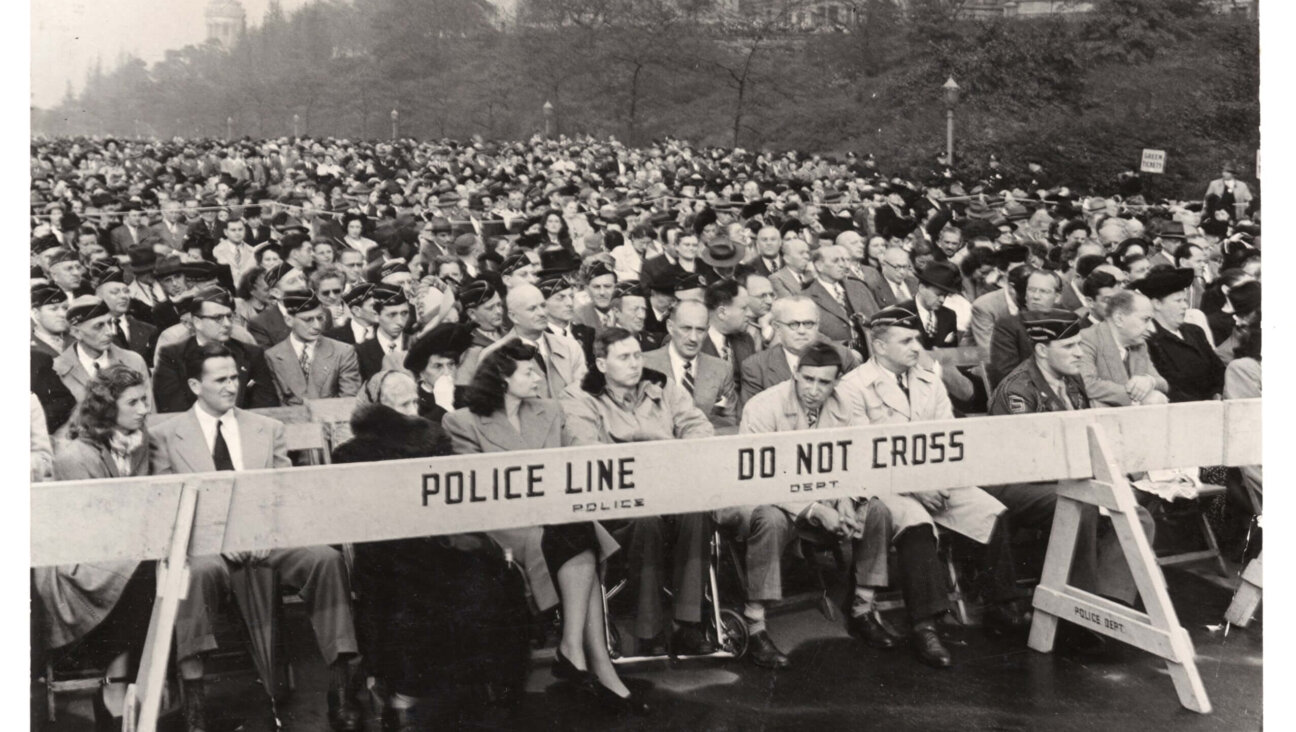Dancing with Demons
Somewhere: The Life of Jerome Robbins
By Amanda Vaill
Broadway, 539 pages, $40.
By all accounts, Jerome Robbins, the man behind “Fancy Free,” “Dances at a Gathering,” “West Side Story” and “Fiddler on the Roof” — and, for many years, George Balanchine’s number two at the New York City Ballet — was a perfectionist, an obsessive tinkerer, an uncompromising taskmaster and, generally speaking, a pain in the neck. He was described variously by collaborators as an “agony” to work with, “venomous,” and “crushing” to the psyches of his dancers. All this is known, and yet somehow still comes as something of a surprise when one thinks of the deep humanity, and empathy, that comes through in his works. And there is no doubt about Robbins’s central place in the world of American ballet. Eight years after his death, his works are in the repertory of most of the major ballet companies in the United States; just this past season, the American Ballet Theatre performed two of his works, and New York City Ballet will be presenting eight — including a major revival — in its upcoming winter season.
Still, his uncongenial character is well documented, not least in two recent biographies, one more disapproving, by Greg Lawrence in 2001, and the other, more equanimous in tone, and more authoritative, by Deborah Jowitt, from 2004. And so it is natural that a similar portrait emerges from Amanda Vaill’s massive new biography, “Somewhere: The Life of Jerome Robbins.” Understandably, Vaill could not avoid recounting episodes of bruised egos and cruel put-downs — during the rehearsals for “Fiddler,” Robbins told one of the actors that he “had to walk out during the wedding scene because the idea of that girl being forced to marry you was so revolting”— and yet, in this account, as in Jowitt’s before it, the overall picture of Robbins’s accomplishments and torments reveals a man who was, ultimately, more appealing and impressive than he was off-putting.
In project after project, from practically teaching himself ballet in his late teens to creating an American idiom in dance and musical theater, Vaill evokes Robbins’s striving to fulfill huge artistic ambitions. In dance, he dreamed not just of becoming a great choreographer but also of creating a “new gestural language… American-accented and expressive.” In theater, his ambitions were, if possible, even greater: He aimed to create a kind of “total theatre” that would encompass music, dancing, and archetypal stories: “the form to be achieved is a real braiding of these three mediums, not a matter of placing them in layers one on top of the other.” And to a significant extent, that’s what he did. “West Side Story” was a paean to modern American street culture, “Dances at a Gathering” a hymn to the ritual and community of dance.
At the same time, Vaill delves into Robbins’s torments, which both fed and inhibited his work: his feelings of inadequacy (as a working-class Jew from New Jersey), imperfection and exposure — first as a homosexual and, most deeply, as an artistic lightweight, especially by comparison with his colleague and idol, Balanchine. To avoid this exposure, Robbins became deeply, obsessively involved in the progression of each project, from idea to execution, and was almost never satisfied with the outcome. In the ballets, he was interested not only in how the movements were performed but also in the intentions behind them, and in the story behind them. And it was not only the execution of the movements he had created that distressed him — and for which he tormented dancers — but also the quality and composition of the movements themselves, which he constantly changed, refined, cut, reshuffled, built upon, retouched.
In the 1950s and ’60s, when he spent most of his time directing and choreographing musicals — and the movies made from them — there were even more layers for him to fret over: music, décor, dialogue, dramatic arc, the delicate balance of story and musical set pieces, even camera angles. Everything mattered, and there were no bounds to his meddling. “Fiddler,” which Robbins directed and choreographed for Broadway, was the epitome of this all-encompassing method, a fact that should come as no surprise: Among the musicals, this was the most closely intertwined with Robbins’s exploration of identity. And perhaps for this very reason, it marked the end of his relationship with Broadway.
Vaill tends to give psychological interpretations for the dark moods and the panic attacks, drawing to a great extent from Robbins’s own musings in his copious journal entries and letters (of which he kept copies). In 1949, when, after the huge success of “Fancy Free,” he was choreographing the show “Miss Liberty,” he wrote to his therapist: “Am I afraid that after this show if it’s NG [no good] I’ll be stuck out on a limb of failure again & cut off. No one will want me. So now the truth of my dependency on success for raison d’etre & for substitute of friends is apparent.”
His feelings about being Jewish were equally conflicted. In 1937 he changed his name from Rabinowitz to Robbins (his parents followed suit), and in the 1970s he wrote in his journal that all his life he had been trying to “assimilate” through his work in order to avoid being unmasked as “a little Jewish kike… the façade of Jerry Robbins would be cracked open, and behind everyone would finally see Jerome Wilson Rabinowitz.”
And then there was his anxiety about being gay. In 1944, a 26-year-old Robbins wrote in his journal, “Please save me from being gay.” (Jowitt includes the words “and dirty” in her version of the quote.) No wonder he was in therapy practically all his adult life.
This last fear — hard as it is to imagine looking back from 2006 — had significant repercussions in his personal and artistic life. Vaill argues convincingly that the fear of being exposed as a homosexual — actually, he was attracted to both men and women, and had relationships with many women — was a major reason behind one of Robbins’s greatest moments of moral weakness: his decision to testify before the House Un-American Activities Committee.
In 1953, Robbins gave “friendly” testimony before HUAC, openly “naming names” of friends and acquaintances with whom he had briefly attended communist meetings in the mid-1940s. Vaill traces how this essentially dishonorable act — the purest expression of his fear of rejection and exposure — ate at him for the rest of his life, so much so that Robbins, who was nothing if not self-aware, was unable to really speak of it for decades.
His fear of exclusion and sense of inferiority also manifested themselves in his dreams, of which he kept detailed transcriptions (Vaill quotes from them). In one, he takes company class with Balanchine and the dancers of the New York City Ballet, only to find that he has been left with the youngest ballet students while all the “big shots” have gone off together. Balanchine’s attitude toward Robbins was complex, a mixture of respect and ever-so-slight condescension; he disliked or was tepid about many of his ballets, including such successful works as “The Cage” and “In the Night.” Vaill even notes that there may have been a touch of homophobia in his attitude. Jowitt, in her biography, takes a more unsentimental approach to Robbins’s psychology, explaining the bouts of anger as part of the choreographic process, without ever excusing them: “Many choreographers have a reputation for being nasty,” she posits, and “every choreographer has experienced times when nothing looks right. Deep down, he or she knows that the problem may lie with the steps, but it’s easier to believe that the dancers just aren’t doing them right or giving their all.” One suspects that she has a point.
This difference in emphasis is fairly indicative of the main divergence in approach between the two biographies, which in other ways have much in common: Both are long; both authors had access to Robbins’s copious archives. (Vaill describes “350 linear feet of files, containing nearly every letter Robbins ever received… as well as journals, datebooks, telephone logs, photographs, videotapes, audiotapes, scenarios, scripts, memoirs, and fictional compositions”); both spoke with many of Robbins’s collaborators, and both have an essentially sympathetic attitude toward their subject. But Jowitt, as a critic who has had a long working knowledge of Robbins’s dances — she has been the senior dance critic at the Village Voice for more than three decades — tends to focus on the work, where Vaill, who previously wrote a biography of the iconic Lost Generation couple Gerald and Sara Murphy, is more interested in the man.
Vaill chronicles at length the ins and outs of his intense and rapidly evolving relationships with men and women; she explores his pattern of “triangulating” affairs with both sexes in order to allow himself wiggle room and a back door; she includes sometimes tasteless comments by Robbins’s friends and colleagues about his (and their own) sex lives. But she isn’t only interested in the affairs. She also lovingly recounts his two visits to the Russian shtetl Rozhanka, where his father was born, and his desolation, in 1959, on discovering that the place of his childhood memories had been erased by World War II and its aftermath. (Thus, “Fiddler” was, for him, a kind of restoration of a lost world.) She offers vivid descriptions of life on the road with Ballet Theatre, with whom, in his early days as a dancer, he performed such works as Fokine’s “Petrouchka” (he danced the leading role and deeply identified with the wretched puppet outcast, as he would later perform and identify with the leading role in Balanchine’s “Prodigal Son”). Vaill truly relishes the material of his life, and delves into it for the meaning of his work. For Jowitt, the boyfriends, the breakups, and the complicated relationships with family and friends recede into the background, while the descriptions of the theatrical works, and especially the dances, crystallize on the page. Vaill explains what the dances are about; Jowitt makes us see them.
At 539 pages (not including notes), “Somewhere” is no walk in the park, and it could have done with some cuts here and there — there is an inevitable amount of repetition as she goes from one show to the next, one relationship to the next, — but Vaill’s engaging prose and enthusiasm for her subject often allow one to forget the book’s heft and lose oneself in the hectic, complicated life of this extraordinary and extraordinarily difficult man.
Marina Harss is a freelance dance writer, translator and researcher at The New Yorker. Her translation of Alberto Moravia’s “Conjugal Love” will appear in January 2007.

I hope you appreciated this article. Before you go, I’d like to ask you to please support the Forward’s award-winning journalism this Passover.
In this age of misinformation, our work is needed like never before. We report on the news that matters most to American Jews, driven by truth, not ideology.
At a time when newsrooms are closing or cutting back, the Forward has removed its paywall. That means for the first time in our 126-year history, Forward journalism is free to everyone, everywhere. With an ongoing war, rising antisemitism, and a flood of disinformation that may affect the upcoming election, we believe that free and open access to Jewish journalism is imperative.
Readers like you make it all possible. Right now, we’re in the middle of our Passover Pledge Drive and we need 500 people to step up and make a gift to sustain our trustworthy, independent journalism.
Make a gift of any size and become a Forward member today. You’ll support our mission to tell the American Jewish story fully and fairly.
— Rachel Fishman Feddersen, Publisher and CEO
Join our mission to tell the Jewish story fully and fairly.
Our Goal: 500 gifts during our Passover Pledge Drive!























